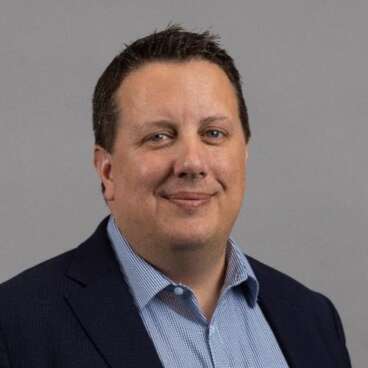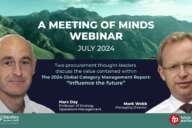Video
Future Purchasing’s KONGSBERG Maturity Assessment Case Study
By Future Purchasing |
Kongsberg maturity assessment
Rob Anthony talks to Mark Webb and Matt Jones about how the Future Purchasing Maturity Assessment has improved the value category management brings to KONGSBERG
The speakers:

Rob Anthony
SVP Global Supply Chain
Kongsberg Maritime
Rob Anthony is responsible for Global Supply Chain in Kongsberg Maritime and Kongsberg Gruppen Supply Chain for Indirect Procurement and Sustainability. He is also UK Country Manager and Board Director of Kongsberg Maritime Ltd.
Rob has 26 years of Procurement and Supply Chain experience and prior to joining KONGSBERG in 2019, he worked for Rolls-Royce Plc, in the Marine, Civil Aerospace and Defence Aerospace Businesses.
Rob has experience of living and working in Germany and Norway and is based in the UK.

Mark Webb
Managing Director
Future Purchasing
Mark is the managing director of Future Purchasing – a specialist procurement consultancy and educational provider. Since establishing the firm in 2003, he has supported over 100 global organisations to successfully implement category and supplier management.
With a career covering multiple sectors – including technology, industrials, energy, pharmaceutical, telecoms, transport, hospitality, media, FMCG, financial services sectors, and the public sector – Mark brings deep cross sector expertise to every client.
Before founding Future Purchasing, Mark spent 11 years in consultancy and operational roles at Price Waterhouse, Mobil Oil and QP Group, where he developed a strong foundation in procurement and business transformation.
He is also the co-author of six influential global reports on category management in collaboration with Henley Business School. The most recent, “Influence the Future”, was published in April 2024 and continues to shape thinking in the procurement profession.

Matt Jones
Director
Future Purchasing
With over 30 years of global consulting and industry experience, I am a proven strategy and operations leader, building organisational capability and capacity to deliver results in complex UK and International environments. During which time I’ve held key roles in government and industry as a commercial, procurement & supply chain professional.
Having a background in engineering and lean operations management, I’ve a successful track record of building and leading high performing teams, firstly at Jaguar Land Rover, then Bunzl, Deloitte and PwC.
I have consulted with organisations across Central and Regional Government, Healthcare, Justice, Defence and Transport. I’ve travelled extensively and enjoyed working with people from different backgrounds and cultures, including 5 years living and working in the Middle East.
I’m passionate about working alongside professionals, to help both individuals and teams to develop and realise their full potential. Utilising data and enabling systems to drive performance and employee & customer satisfaction.
With a growing interest in the deployment and adoption of enabling digital technologies, often using Artificial Intelligence, that are impacting our personal and professional lives.
Transcript
Mark Webb
Hi, Rob. Thanks for joining us today. We work with you recently. Really enjoyed it. Looking at the Catman maturity within Kongsberg. And we’ve got a few questions we wanted to ask you about the approach and the value in the team that you and the team got from it. So. Well, firstly, would you like to tell us a little bit about yourself and Kongsberg?
Rob Anthony
Thanks, Mark. Pleasure to be here. My name is Rob Anthony. I’ve worked in supply chain for over 26 years. I did 20 years with Rolls-Royce Aerospace and Marine and then, six years ago, I moved over to Kongsberg when Kongsberg acquired Rolls-Royce marine. And I’ve been working in Kongsberg maritime, but also with the group. My role since then, my career has mainly been in supply chain, but procurement, logistics and planning. And to talk a bit about Kongsberg. So Kongsberg means kings Mountain. Khong is king, Berg is mountain. It’s a company that’s actually existed since 1814, actually created when Norway got its first constitution and has a strong defense business. Historically as well. And then since oil was formed, has increasingly a strong maritime business. And with the acquisition of Rolls-Royce marine six years ago, maritime is the biggest business with defense also a very, very strong, business. We also have two other business areas in the company, one called Kongsberg Discovery, which is about discovering the ocean, subsea, capabilities, and surveillance. And we also have a smaller, digital business. So as a company, it is a Norwegian company, with locations in 40 countries, just over 14,000 employees and just, nearly, 50 billion NOK in revenue. So quite exciting business, across defense, maritime businesses globally.
Mark Webb
Right. And how is supply chain set up with maritime.
Rob Anthony
Yeah. So I can talk about supply chain just as a, as a group level and then about maritime. So, Kongsberg has quite a small, headquarters. So, group responsibilities are sitting within the different business, what we call business areas. I’m responsible for group indirect and group supply chain activity, sitting within the maritime business. And as an example, the CIO for it actually sits within defense business. So we have different roles sitting in the different business areas. But within those strong, business areas with a very small headquarters, we have divisions. Divisions are organized by group products and systems. And, you know, and then within those divisions, we have business units that are also aligned by product, family and, PNL and we really are focused on having a product line structure. So how, focused on our customers. So how is supply chain set up? Well, the majority of our supply chain businesses actually sit within those divisions and business units, close to the sites. And, and also in the regions around the world, particularly USA, Americas, EMEA and Asia. But we also have a smaller central team, covering, shared services, process tools and capabilities and areas that we’ve agreed will be, will be better when, when centrally. As part of that, we also have a team not just in Norway, but, you know, around the world, but we also have a team, a shared service office for supply chain that we’ve established in Krakow. We established that when we involved voice and we’ve continue with that, and we now have over 60 people, supporting multiple businesses, across Kongsberg, on supply chain and procurement.
Mark Webb
Excellent. Yeah. So I was wondering, Rob, how long have you guys been doing category management for.
Rob Anthony
Yeah. Thank you. That’s a that’s a good question. So, we actually in business marine, set up strategic procurement from, from around, 2011. And we’ve been really deploying strategic procurement and category management since then. So about, 14, 15 years, it’s been a journey, in our maritime business, there was a very strong growth period until around 2015, when there was, a downturn. And actually now we’re seeing maritime is also in a growth period. So obviously category management has different priorities when you’re in a growth or in a, in a downturn. Obviously, we’re still focused on the key areas, but maybe, maybe with different priorities. So, strategic procurement has continued since then. We have some of our, people have been, category managers and working in strategic procurement for that time frame. So we have some as a good level of experience, but we also have new technologies and also new regions that we’re covering that we need to be ready for our main challenges right now, being ready for the growth, making sure we’ve got enough capability and capacity around the world. And also skill sets that we have skills and capability to manage those, those categories.
Matt Jones
Hi, Rob. I was just going to I mean, you started to talk about it anyway, but I was going to just ask you a question about, you know, the opportunity you feel there is in category management. We’ve met a lot of your team and we’ve, we’ve been talking to you for a while and understand that you’re good in many areas of category management, but just what do you think the opportunity is now to go from good to great?
Rob Anthony
Yes. Thank you. Thank you for the question. So, we we’ve been doing category management for a while and strategic procurement and, you know, quality, cost delivery. We feel that we’re delivering, a good level, a reasonable level of cost savings every year. We’ve got good sourcing plans. We’ve got a reasonable level of contract coverage. We have good supplier engagement. So that’s fine. You know, we don’t need to do anything else. But if you take a step back and you say, actually, we’re capturing the full strategic value that we could put to strategic procurement and management. That is a question. And do we need to look at things, with an independent view to sort of test where we are, compare ourselves with, competitors or with other good industrial benchmarks and say, okay, we might be doing, as you said, a good job, but are we doing a great job? And how can we actually, understand what that gap might be. So really, the reason, that, we worked with Future Purchasing and we decided to take a look at category management was, was more around opportunity, you know, what more opportunities there. How can we maximize the strategic value? And the reality is that 95% of people in supply chain are working on operations or working on deliveries for this year. So how do we uplift and how do we think about capturing our strategic value and also thinking about risk management? At its 2013 up to 2035,
Matt Jones
Great. I was going to just say, you know, we worked with you for a really rapid sort of maturity assessment and, I was just interested to see how you felt. We as a team worked with your team and just maybe you can share some insights in terms of the approach and what you felt was of value.
Rob Anthony
Yeah. So we kicked off a piece of work with future purchasing. We actually worked with you before, I think about 8 or 10 years ago. And we knew each other, and we stayed in contact, and we felt now was the right time to do it, to do a benchmark. What we were looking for was an independent assessment, and also more of an advisory engagement where you, you come in, we work together, you do some kind of holistic, evaluation with some industry benchmarks. We can have a good engagement discussion about that, and then we can, you know, build that into our strategy for the future. So that was the, that was the goal. Working with future purchasing went very well. I think you’re very open. I think we have a good sounding board discussion. One very important point is your listening, which we appreciate because one of the challenges when you’re doing benchmarks is, fixed views on applicability, which may be different on the industry. So, getting a tailored benchmark that can fit with the industry while still bringing in the benchmarks and challenging yourself is is important. And when we talk particularly about maritime, maritime doesn’t fit easily into the benchmarks. You know, when you look at the drop down menus on these, there’s maritime is never on there, you know? So aerospace, transportation, industrial, equipment. So getting, we found it hard in the past to get good tailored benchmarks for maritime. So that’s, we definitely found it very useful engaging with future purchasing and fitting the benchmarks with our business.
Matt Jones
So one of the things, observations I have, is we spoke to you about in a series of questions that we would we’ve asked the industry over many years and how they would, how you’d score yourself or your team score themselves. But also you asked us to tailor some of the questions specifically to, to your business.
Rob Anthony
Yes, we did. And, we appreciate that. And we also, agreed to do interviews rather than, a survey by email. That is we do a lot of surveys. Also, really getting that 1 to 1 engagement through interviews. People open up a bit more, and, and also in Norway and maybe pass the Norwegian culture in the company. The importance of dialog is very important. And what they talk about is direct dialog. So you actually speak 1 to 1 with someone and you have direct dialog on and, on the topic. And you allowed air to breathe. Have time to sort of talk about it, without rushing the conversation. So having, 1 to 1 interviews with enough time really allow people to open up, and pull that information through, and lastly, actually get them engaged, because if you interview people and then you start to do an improvement program, people feel connected because they’ve already given their input.
Mark Webb
And, Rob, how did you find the six dimension approach that, we used? Because, that was pretty fundamental to the approach.
Rob Anthony
And so I think it’s actually behind you on the wall, in the six aspects. So, you know, we can see the different aspects that we looked at. And the reason we found this very positive was bringing in a different aspects. So we’re looking we’re open minded, we look at different areas. Maybe we hadn’t thought about, I’m looking at your chart behind you, but we have, process and technology, stakeholder engagement, capability and mindset, organization structure, different areas. Maybe we hadn’t thought about, and then focusing not just on cost for the value.
Matt Jones
That’s really good. And I suppose just to finish, you know, we’ve worked with you on the maturity assessment. You’ve got some insights, you, you’ve started to do something with those insights. What next in terms of how you taking forward the, the value that you found from the exercise?
Rob Anthony
Yeah. So we’re actually taking, strategic we’re putting a strategic improvement plan together, taking into account the feedback from future purchasing, but our own, we actually had a full on workshop after our engagement with each purchasing in terms of also getting the feedback directly from the team. And then we’re going to be building that into, into our improvement, strategic improvement program for cash management and strategic procurement moving forward. We’re already getting good questions from the business. You know, what is the strategy for 2035? How are we going to manage risk management in the future? How will we I think the phrase is being is future proof. How are we able to take advantage of the opportunities but also have the flexibility to cope with the global risks that are out there at the moment? And the dynamics that we see, that take us on, on its growth path. So we’re going to be looking at all those aspects also looking at digitalization and how can we also do things in more efficiently as well and more effectively? So we’re going to look at all those aspects and build that into the plan. We have some milestones coming up. So we actually have Global supply conference in, in October. We’re going to try to, be able to share the framework a little bit also with our strategic suppliers, when we have that event. So we’re not going to rush it. We’re already delivering. So we’re going to continue delivering, but we’re going to try to really build that plan. And then work out which priority areas we want to do first.
Matt Jones
Great. Then we’ve reached the end of this interview. I think, Mark, you maybe have one last question and then we’ll try and wrap up.
Mark Webb
Yeah. We just you know, the one key takeaway you would say, Rob, from your engagement with us over the last few months now.
Rob Anthony
Thank you. Mark. So my one, if there’s one key takeaway from this activity, our, president, Lisa, she has introduced a value for us to consider in the company last year, which we’re continuing with, which is being curious or staying curious, curiosity. So what does that mean? What that means? As a value, that means that you’re open minded, you’re open to new ideas, you’re willing to look at new ideas, you’re open to feedback. And that’s something that we’re trying to bring through a whole business and is very relevant to what we’ve done with future purchasing. So staying curious is, is my big, takeaway at the end.
Mark Webb
Excellent. Well, hopefully all of the ideas that the maturity assessment threw out, which was, was a heck of a lot, which hopefully we distill down quite neatly. But yeah, there was a lot of curiosity from the teams on how they could improve for sure. Thank you. Thank you all. Thanks. Appreciate it.




